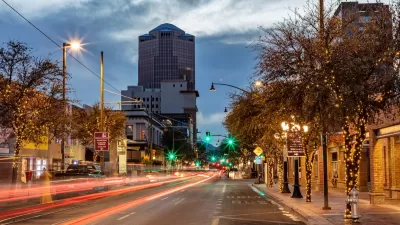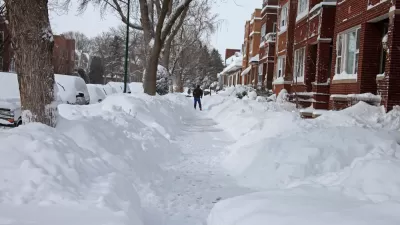In theory, sidewalks are what make cities walkable. But in Washington, D.C., many sidewalks are not accessible to the people who use them.

Barbara Moreno writes about Project Sidewalk, an online crowdsourced accessibility audit of sidewalks in Washington, D.C. Volunteers reported sidewalk obstructions on almost 1,500 miles of city sidewalks, and an interactive map shows the results. Sidewalk accessibility was most often impeded by obstructions such as trash cans, notes Moreno. A lack of curb ramps and surface problems—a broken pavement, for example—were the other most common impediments.
The most issues were located around the National Mall. The findings also show that sidewalk obstructions were not limited to less affluent neighborhoods: half of neighborhoods with the most obstructions were in high-income D.C. neighborhoods.
The Project Sidewalk findings illustrate how the presence of sidewalks does not automatically mean neighborhoods are walkable and accessible. "For parents pushing babies around in strollers, a big crack in a sidewalk can be an unwelcome nuisance. For wheelchair users and others with limited mobility, obstructions like these can make a sidewalk almost entirely inaccessible. A city is only as accessible as its sidewalks. And access to quality sidewalks is paramount for all people walking," says Moreno.
FULL STORY: A city is only as accessible as its sidewalks. This map shows DC’s are often blocked.

Planetizen Federal Action Tracker
A weekly monitor of how Trump’s orders and actions are impacting planners and planning in America.

San Francisco's School District Spent $105M To Build Affordable Housing for Teachers — And That's Just the Beginning
SFUSD joins a growing list of school districts using their land holdings to address housing affordability challenges faced by their own employees.

The Tiny, Adorable $7,000 Car Turning Japan Onto EVs
The single seat Mibot charges from a regular plug as quickly as an iPad, and is about half the price of an average EV.

With Protected Lanes, 460% More People Commute by Bike
For those needing more ammo, more data proving what we already knew is here.

In More Metros Than You’d Think, Suburbs are Now More Expensive Than the City
If you're moving to the burbs to save on square footage, data shows you should think again.

The States Losing Rural Delivery Rooms at an Alarming Pace
In some states, as few as 9% of rural hospitals still deliver babies. As a result, rising pre-term births, no adequate pre-term care and "harrowing" close calls are a growing reality.
Urban Design for Planners 1: Software Tools
This six-course series explores essential urban design concepts using open source software and equips planners with the tools they need to participate fully in the urban design process.
Planning for Universal Design
Learn the tools for implementing Universal Design in planning regulations.
Smith Gee Studio
City of Charlotte
City of Camden Redevelopment Agency
City of Astoria
Transportation Research & Education Center (TREC) at Portland State University
US High Speed Rail Association
City of Camden Redevelopment Agency
Municipality of Princeton (NJ)





























